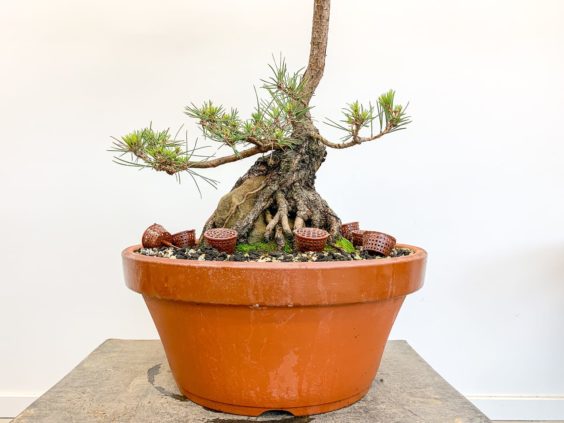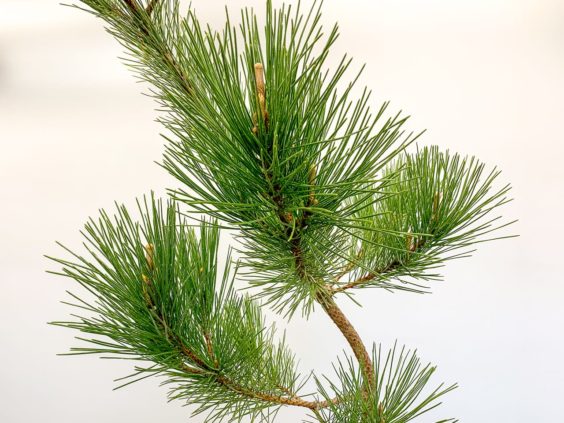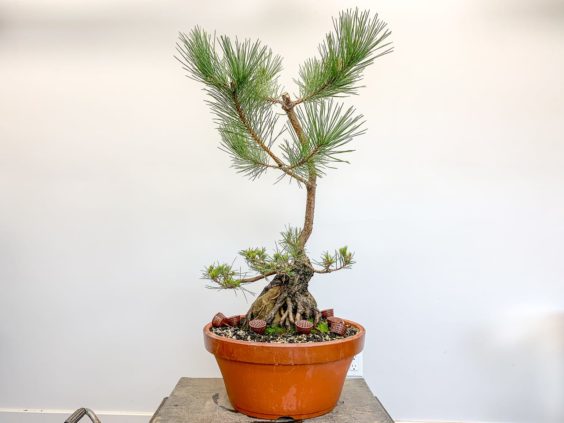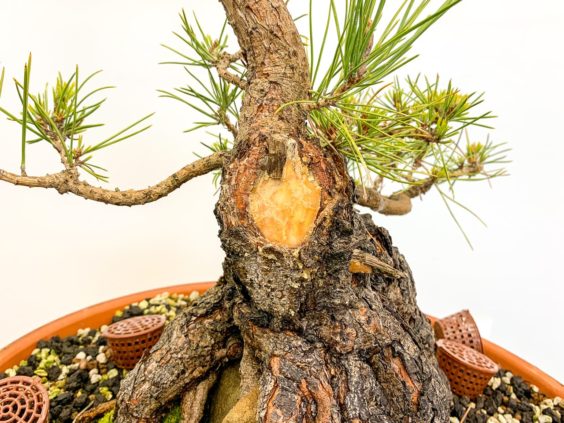The basic approach to developing material for bonsai is to first create the trunk and then focus on the branches. In between these two stages, it’s common to split the focus between the trunk and the branches.
When focusing on the branches, the idea is to slow the tree down to produce fine growth. When focusing on the trunk, the goal is to get as much growth as quickly as possible.
When aiming for both on the same tree, it’s common for the future branches to become weak, especially if they’re located below vigorous sacrifice branches. Here’s an example of this.
Root over rock black pine with a strong sacrifice branch
The future tree will be relatively small. To improve the ramification on the future primary branches, I decandled the lower part of the tree last June. The summer buds that resulted were very small.
Weak summer growth on the future primary branches
Part of this is due to a cold summer. When summer temps are low, budding after decandling is weak. The bigger problem is that the sacrifice branch is too large in relation to the decandled branches.
Vigorous growth on the sacrifice branch
When a tree is partially decandled, the decandled branches slow down and the remaining branches gain vigor. When the decandled branches are weak to start with, then get even weaker. That was the situation with this tree.
The solution is to cut back the sacrifice branch.
After reducing the sacrifice branch
If I had made these cuts when I decandled the tree last year, I could have expected better summer growth on the lower branches. This year I’ll skip decandling the lower branches, and I might even decandle the sacrifice branch to encourage the tree to produce more vigorous growth below.
Why keep the sacrifice branch at all? The main reason is to heal a large wound left after removing a previous sacrifice branch. Once this wound closes, I’ll remove the current sacrifice branch and focus on developing the remaining branches.
Wound created by removing a large sacrifice branch
Subscribe to Bonsai Tonight
New Posts Delivered Every Tuesday and Friday





Doug Zeeff says
Jonas, that is a large wound created by the branch removal. Did you apply any wound sealer at the time of removal? What time of year do you consider optimal for such major pruning?
Jonas Dupuich says
Hi Doug – I don’t remember whether or not there was sealant on the large wound earlier. I typically use cut paste and will apply some soon after re-opening the wound a bit to stimulate callus formation.
As for the best time of year for big cuts, I have yet to see enough of a difference to make a strong recommendation. I’ve done it in fall, in early spring, and in summer. In each case I pay more attention to where the branch is and the potential effect on nearby branches, the stage of development, and the overall health of the tree.
Ann says
Jonas – when you cut the sacrifice branch you’ll end up with another large wound. Will you need to grow another sacrifice branch to heal that wound – and when do you stop this cycle? It seems to me you could be growing sacrifice branches for ever to heal the wound from the previous one.
Jonas Dupuich says
Hi Ann – great question! The cycle can repeat several times throughout development but at some point large sacrifice branches are no longer required and the wounds are small enough to heal on their own. When the wounds are large, letting a branch run for a year or two is a great way to accelerate healing. I’ll make a few posts on the topic – I have a few examples of trees at different stages in this process. Thanks for writing!
Kip says
What’s the age of this tree? And how/where did it come into being…seed?
Jonas Dupuich says
Hi Kip – I think the tree is 12 or 13 years old. Eric Schrader started it, likely from seed.